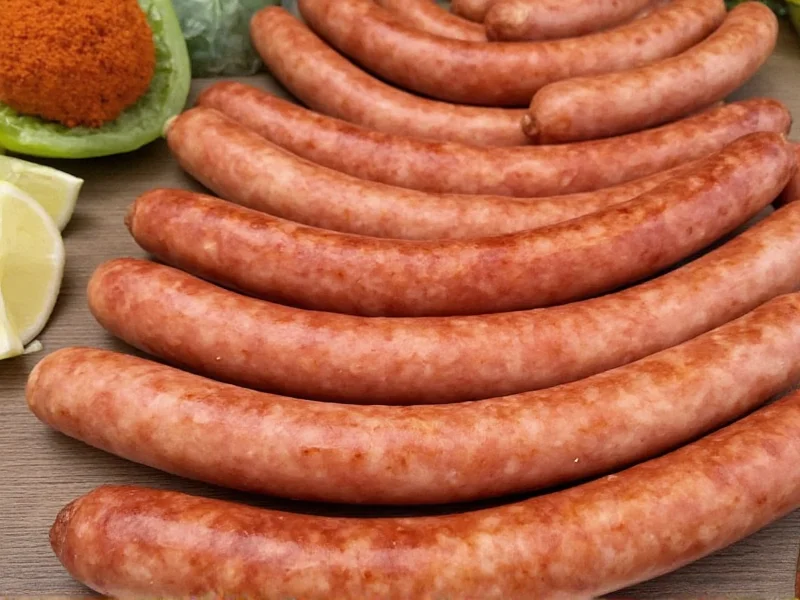Discover the art of creating authentic pickled sausages with this time-tested recipe that balances tangy vinegar notes with warm spices. Unlike quick refrigerator pickles, this traditional Scandinavian preparation method develops complex flavors through proper brine composition and adequate marinating time. Whether you're preserving summer sausages or preparing a classic Danish stjælerpølse, this guide provides everything you need for perfect results every time.
Why This Pickled Sausage Recipe Works
This authentic preparation method succeeds where many online recipes fail by maintaining the proper acid balance for both safety and flavor development. The critical 1:1 vinegar-to-water ratio creates an environment that safely preserves the sausages while allowing the spices to fully infuse. Unlike recipes that use excessive sugar, this balanced approach prevents overwhelming the delicate sausage flavors while still mellowing the vinegar's sharpness.
Professional chefs emphasize that the marinating duration significantly impacts texture—too short (under 72 hours) yields underdeveloped flavors, while too long (beyond 10 days) can make the sausages unpleasantly soft. This recipe's precise 3-7 day refrigeration window delivers optimal results for most sausage varieties.
Essential Ingredients for Authentic Pickled Sausage
The quality of your ingredients directly affects the final product. Choose these specific components for best results:
| Ingredient | Quantity | Preparation Notes |
|---|---|---|
| Pre-cooked sausages | 2 lbs (900g) | Weisswurst, frankfurters, or kielbasa work best; avoid smoked varieties |
| Distilled white vinegar | 2 cups (480ml) | Do not substitute with lower-acid vinegars |
| Water | 2 cups (480ml) | Filtered preferred |
| Brown sugar | 1 cup (200g) | Packed light brown sugar for balanced sweetness |
| Mustard seeds | 2 tbsp | Yellow or brown seeds, slightly crushed |
| Whole peppercorns | 1 tbsp | Mixed black and white for complexity |
| Bay leaves | 3 | Dried, not fresh |
| Onion, thinly sliced | 1 medium | Yellow or sweet onion preferred |
Equipment Checklist
- Quart-sized mason jars with airtight lids (sterilized)
- Medium saucepan (non-reactive: stainless steel or enamel)
- Wooden spoon
- Slotted spoon
- Funnel (for clean jar filling)
- Refrigerator space for 7+ days
Step-by-Step Preparation Guide
Preparing the Sausages
Carefully prick each sausage 4-5 times with a toothpick to allow the brine to penetrate without splitting the casing. Place sausages in a large bowl and cover with boiling water. Let stand for 5 minutes, then drain and cool completely. This critical step removes surface impurities while keeping the sausages intact.
Creating the Perfect Brine
In your saucepan, combine vinegar, water, brown sugar, mustard seeds, peppercorns, and bay leaves. Bring to a gentle boil over medium heat, stirring until sugar dissolves completely. Reduce heat and simmer for 5 minutes to allow flavors to meld. Remove from heat and cool to room temperature—never pour hot brine over sausages as this would cook them further and ruin the texture.
Assembly and Marinating
Place cooled sausages upright in sterilized jars with onion slices between them. Pour cooled brine over sausages, ensuring complete coverage with ½ inch headspace. Seal jars tightly and refrigerate. For optimal flavor development, wait at least 72 hours before eating, gently turning jars daily to redistribute spices. The sausages reach peak flavor between day 4-7 of marinating.
Storage and Serving Recommendations
Properly prepared refrigerator pickled sausages maintain best quality for 3-4 weeks when continuously refrigerated. Always use clean utensils when removing sausages to prevent contamination. For traditional Scandinavian presentation, serve sliced thin on rye bread with mustard and pickled beets. They also make excellent additions to charcuterie boards or can be chopped for potato salad.
Troubleshooting Common Issues
Cloudy brine: Usually indicates mineral content in water or impurities from spices. While safe, use filtered water next time for clearer results. Soggy texture: Likely marinated too long—reduce future batches to 5 days maximum. Weak flavor: Increase marinating time or add additional spices to the brine. Mold formation: Discard immediately—this indicates improper sealing or contamination during preparation.
Delicious Recipe Variations
For a spicy version, add 1-2 sliced jalapeños and ½ teaspoon red pepper flakes to the brine. Try a sweet & sour variation by replacing ½ cup vinegar with apple cider vinegar and adding 2 sliced tart apples to the jars. The Scandinavian holiday style includes allspice berries and a cinnamon stick for festive occasions. For quick refrigerator pickles, reduce marinating time to 24 hours but expect less developed flavors.
Safety Considerations for Home Pickling
This refrigerator pickle method is safe when followed precisely because it relies on refrigeration rather than canning for preservation. Never attempt to can pickled sausages using this recipe, as improper canning of meat products can create dangerous botulism risks. Always maintain refrigeration below 40°F (4°C) and discard if any off odors develop. The vinegar-to-water ratio must remain at 1:1 for proper acidity—do not alter this balance.











 浙公网安备
33010002000092号
浙公网安备
33010002000092号 浙B2-20120091-4
浙B2-20120091-4